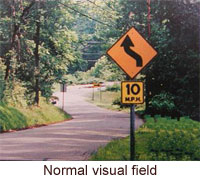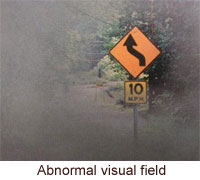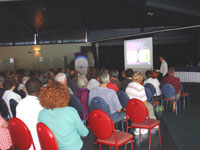

Glaucoma is an eye disease in which the normal fluid pressure inside the eye rises, leading to vision loss – or even blindness.
 At the front of the eye, there is a small space called the anterior chamber. Clear fluid flows in and out of the chamber to bathe and nourish nearby tissues. The balance between how much fluid is made and how much fluid leaves the eye determines the pressure in the eye. If all is working well, the fluid made inside the eye equals the amount of fluid leaving the eye, and the intraocular pressure is normal. In glaucoma, for still unknown reasons, the fluid drains too slowly out of the eye. As the fluid builds up, the pressure inside the eye rises.
At the front of the eye, there is a small space called the anterior chamber. Clear fluid flows in and out of the chamber to bathe and nourish nearby tissues. The balance between how much fluid is made and how much fluid leaves the eye determines the pressure in the eye. If all is working well, the fluid made inside the eye equals the amount of fluid leaving the eye, and the intraocular pressure is normal. In glaucoma, for still unknown reasons, the fluid drains too slowly out of the eye. As the fluid builds up, the pressure inside the eye rises.
What harm does high pressure do to an eye? The weakest and most delicate structure of the eye is the optic nerve. Unless high pressure in the eye is controlled, it may cause damage to the optic nerve which is at the back of the eye. The optic nerve cells' job is to transform the light entering the eye into electrical impulses that can be understood by the brain. Every person has a different pressure to which their eye is sensitive. The optic nerve cells become damaged when the pressure is too high for the nerve cells in that particular eye to tolerate. If enough of these cells die then some vision may be lost. At first, there are no symptoms. Vision stays normal, and there is no pain. Subsequently, as the cells die vision is slowly lost forever.
How Much Do You Know About Glaucoma?
Glaucoma is New Zealand’s leading cause of preventable blindness, but many people are unsure about what it is, and what they can do to avoid vision loss from glaucoma. Yet the news is mainly positive! With early diagnosis and proper care the vast majority of glaucoma patients will retain their sight. The key is early detection.
What is glaucoma?
Glaucoma is a name given to a group of diseases in which the optic nerve at the back of the eye is damaged, usually due to the pressure inside the eyeball being too high.
How will I know if I develop glaucoma?
The best way to detect glaucoma is to have regular eye examinations by an optometrist or eye specialist from the age of 45, or earlier if there is glaucoma in your family. This way warning signs will be picked up early. In the early stages of glaucoma there are no apparent symptoms, but damage is occurring that can never be repaired.
What is the treatment for glaucoma?
There are a range of treatments available, all aimed at lowering the pressure within the eye and preventing further vision loss. Most commonly medication is delivered in the form of regular eye drops.
Who has glaucoma?
A family history of glaucoma greatly increases your likelihood of developing it. Glaucoma can occur at any age, but it is increasingly likely as we get older. Also at increased risk are people with diabetes, high blood pressure or myopia.
Although older people are at a higher risk for glaucoma, people of all ages including babies and young adults can get glaucoma. Glaucoma affects 2% of the population over the age of 40 years, and 10% of those over the age of 70. However, with proper care less than 2% of patients with glaucoma will go blind.
 Glaucoma New Zealand
Glaucoma New Zealand
Glaucoma New Zealand is a charitable trust formed to save sight by preventing blindness from glaucoma.
Glaucoma NZ aims to offer a free, approachable, information service to people affected by glaucoma, to their families, and to health care professionals involved in glaucoma diagnosis and treatment. We also promote awareness of glaucoma in the community.
Services that Glaucoma New Zealand offer include:
- A glaucoma membership information package.
- Regular public meetings to educate people with glaucoma, to help them understand their eye disease and the best treatment of it.
- “Eyelights”: our regular newsletter.
- Fact Sheets: information on specific aspects of the glaucomas.
- Public awareness campaigns to aid early detection of glaucoma.
- Website www.glaucoma.org.nz
 Glaucoma is one of the leading health issues affecting New Zealanders.
Glaucoma is one of the leading health issues affecting New Zealanders.
- Glaucoma is the leading cause of preventable blindness in New Zealand. Early detection, appropriate diagnosis and the most appropriate treatment can prevent the loss of vision that occurs from this potentially devastating disease.
- Glaucoma affects 2% of the population over the age of 40 years.
- One out of every 10 adults over the age of 70 has glaucoma.
- Although older people are at a higher risk for glaucoma, people of all ages including babies and young adults can get glaucoma.
- Glaucoma is known as the ‘silent thief of sight’ because it is a disease of the eye that can remain without symptoms for a number of years while visual loss is slowly occurring.
- With proper care less than 2% of patients with glaucoma will go blind.
What do we do?
 Information and Education
Information and Education
- Presentations at public meetings around the country
- Free information packs for people who register with us
- Quarterly newsletter: Eyelights
- Advisory service
- Fact Sheets for distribution by ophthalmologists and optometrists
Public Awareness
- Website www.glaucoma.org.nz
- Publicity campaigns eg ‘Mayors for Sight’
- Public meetings open to all
Professional Education
- Professional Education Package for optometrists
Research
- Applications have been received for a research grant for research to be carried out in 2007








Join the Discussion
Type out your comment here:
You must be logged in to post a comment.